Driving Factors behind Energy-Related Carbon Emissions in the U.S. Road Transport Sector: A Decomposition Analysis
Abstract
:1. Introduction
2. Literature Review
2.1. Factors That Influence the Emissions from Road Transport
2.2. Decomposition Analysis Methods
3. Method
3.1. Evaluation of CO2 Emissions in Road Transport
3.1.1. Data Collection
3.1.2. CO2 Emissions Evaluation
3.2. The LMDI Decomposition Approach
4. Results
4.1. CO2 Emissions of the U.S. Road Transport Sector
4.2. Decomposition Analysis of the U.S. Road Transport Sector
4.2.1. The U.S. Road Passenger Transport Sector
Positive Factors
Negative Factors
4.2.2. The U.S. Road Freight Transport Sector
Positive Factors
Negative Factors
5. Discussion
6. Conclusions
Author Contributions
Funding
Institutional Review Board Statement
Informed Consent Statement
Data Availability Statement
Conflicts of Interest
References
- The White House. FACT SHEET: U.S. Reports Its 2025 Emissions Target to the UNFCCC. Available online: https://obamawhitehouse.archives.gov/the-press-office/2015/03/31/fact-sheet-us-reports-its-2025-emissions-target-unfccc (accessed on 16 November 2020).
- The White House. FACT SHEET: President Biden Sets 2030 Greenhouse Gas Pollution Reduction Target Aimed at Creating Good-Paying Union Jobs and Securing U.S. Leadership on Clean Energy Technologies. Available online: https://www.whitehouse.gov/briefing-room/statements-releases/2021/04/22/fact-sheet-president-biden-sets-2030-greenhouse-gas-pollution-reduction-target-aimed-at-creating-good-paying-union-jobs-and-securing-u-s-leadership-on-clean-energy-technologies/ (accessed on 12 January 2022).
- Greene, D.L.; Plotkin, S. Reducing Greenhouse Gas Emission from US Transportation; Pew Center on Global Climate Change: Arlington, VA, USA, 2011. [Google Scholar]
- U.S. Environmental Protection Agency. Sources of Greenhouse Gas Emissions. Available online: https://www.epa.gov/ghgemissions/sources-greenhouse-gas-emissions (accessed on 26 August 2020).
- U.S. Energy Information Administration. Oil and Petroleum Products Explained—Use of Oil. Available online: https://www.eia.gov/energyexplained/oil-and-petroleum-products/use-of-oil.php (accessed on 26 August 2020).
- U.S. Energy Information Administration. Annual Energy Outlook 2020 with Projections to 2050. Available online: https://www.eia.gov/outlooks/aeo/pdf/AEO2020%20Full%20Report.pdf (accessed on 26 August 2020).
- U.S. Environmental Protection Agency. Fast Facts on Transportation Greenhouse Gas Emissions 1990–2018. Available online: https://www.epa.gov/greenvehicles/fast-facts-transportation-greenhouse-gas-emissions (accessed on 27 August 2020).
- Shahiduzzaman, M.; Layton, A. Decomposition analysis for assessing the United States 2025 emissions target: How big is the challenge? Renew. Sustain. Energy Rev. 2017, 67, 372–383. [Google Scholar] [CrossRef] [Green Version]
- Zhang, G.; Wu, L.; Chen, J. Measurement Models for Carbon Dioxide Emission Factors of Passenger Cars Considering Characteristics of Roads and Traffic. Int. J. Environ. Res. Public Health 2021, 18, 1594. [Google Scholar] [CrossRef] [PubMed]
- Wang, W.; Zhang, M.; Zhou, M. Using LMDI method to analyze transport sector CO2 emissions in China. Energy 2011, 36, 5909–5915. [Google Scholar] [CrossRef]
- Lu, I.; Lin, S.J.; Lewis, C. Decomposition and decoupling effects of carbon dioxide emission from highway transportation in Taiwan, Germany, Japan and South Korea. Energy Policy 2007, 35, 3226–3235. [Google Scholar] [CrossRef]
- Gambhir, A.; Lawrence, K.; Tong, D.; Martinez-Botas, R. Reducing China’s road transport sector CO2 emissions to 2050: Technologies, costs and decomposition analysis. Appl. Energy 2015, 157, 905–917. [Google Scholar] [CrossRef] [Green Version]
- Lakshmanan, T.; Han, X. Factors underlying transportation CO2 emissions in the USA: A decomposition analysis. Transp. Res. Part D Transp. Environ. 1997, 2, 1–15. [Google Scholar] [CrossRef]
- McCollum, D.; Yang, C. Achieving deep reductions in US transport greenhouse gas emissions: Scenario analysis and policy implications. Energ Policy 2009, 37, 5580–5596. [Google Scholar] [CrossRef]
- Kwon, T.-H. Decomposition of factors determining the trend of CO2 emissions from car travel in Great Britain (1970–2000). Ecol. Econ. 2005, 53, 261–275. [Google Scholar] [CrossRef]
- Papagiannaki, K.; Diakoulaki, D. Decomposition analysis of CO2 emissions from passenger cars: The cases of Greece and Denmark. Energy Policy 2009, 37, 3259–3267. [Google Scholar] [CrossRef]
- Wang, T.Y.; Li, H.Q.; Zhang, J.; Lu, Y. Influencing Factors of Carbon Emission in China’s Road Freight Transport. Procedia—Soc. Behav. Sci. 2012, 43, 54–64. [Google Scholar] [CrossRef] [Green Version]
- Li, H.; Lu, Y.; Zhang, J.; Wang, T. Trends in road freight transportation carbon dioxide emissions and policies in China. Energy Policy 2013, 57, 99–106. [Google Scholar] [CrossRef]
- Mraihi, R.; Harizi, R. Road Freight Transport and Carbon Dioxide Emissions: Policy Options for Tunisia. Energy Environ. 2014, 25, 79–92. [Google Scholar] [CrossRef]
- Talbi, B. CO2 emissions reduction in road transport sector in Tunisia. Renew. Sustain. Energy Rev. 2017, 69, 232–238. [Google Scholar] [CrossRef]
- Su, B.; Ang, B.W. Structural decomposition analysis applied to energy and emissions: Some methodological developments. Energy Econ. 2012, 34, 177–188. [Google Scholar] [CrossRef]
- Wang, H.; Ang, B.; Su, B. Assessing drivers of economy-wide energy use and emissions: IDA versus SDA. Energ Policy 2017, 107, 585–599. [Google Scholar] [CrossRef]
- Mousavi, B.; Lopez, N.S.A.; Biona, J.B.M.; Chiu, A.S.; Blesl, M. Driving forces of Iran’s CO2 emissions from energy consumption: An LMDI decomposition approach. Appl. Energy 2017, 206, 804–814. [Google Scholar] [CrossRef]
- Huang, F.; Zhou, D.; Wang, Q.; Hang, Y. Decomposition and attribution analysis of the transport sector’s carbon dioxide intensity change in China. Transp. Res. Part A Policy Pract. 2019, 119, 343–358. [Google Scholar] [CrossRef]
- Wu, P.; Song, Y.; Zhu, J.; Chang, R. Analyzing the influence factors of the carbon emissions from China’s building and construction industry from 2000 to 2015. J. Clean. Prod. 2019, 221, 552–566. [Google Scholar] [CrossRef]
- Ang, B.W. Decomposition analysis for policymaking in energy: Which is the preferred method? Energ Policy 2004, 32, 1131–1139. [Google Scholar] [CrossRef]
- Cole, T.J.; Altman, D.G. Statistics notes: Percentage differences, symmetry, and natural logarithms. BMJ 2017, 358, j3683. [Google Scholar] [CrossRef] [PubMed] [Green Version]
- Dong, F.; Pan, Y. Evolution of renewable energy in BRI countries: A combined econometric and decomposition approach. Int. J. Environ. Res. Public Health 2020, 17, 8668. [Google Scholar] [CrossRef]
- Oak Ridge National Laboratory. Transportation Energy Data Book, 38.2 ed. Available online: https://tedb.ornl.gov/wp-content/uploads/2020/02/TEDB_Ed_38.pdf#page=61 (accessed on 4 October 2021).
- U.S. Energy Information Administration. Carbon Dioxide Emissions Coefficients. Available online: https://www.eia.gov/environment/emissions/co2_vol_mass.php (accessed on 20 May 2019).
- U.S. Energy Information Administration. Electricity. Available online: https://www.eia.gov/electricity/data.php#generation (accessed on 20 May 2019).
- Ang, B.W. The LMDI approach to decomposition analysis: A practical guide. Energ Policy 2005, 33, 867–871. [Google Scholar] [CrossRef]
- OECD. Passenger Transport. Available online: https://data.oecd.org/transport/passenger-transport.htm#indicator-chart (accessed on 10 December 2020).
- OECD. Freight Transport. Available online: https://data.oecd.org/transport/freight-transport.htm#indicator-chart (accessed on 10 December 2020).
- The World Bank. United States. Available online: https://data.worldbank.org/country/united-states (accessed on 22 October 2020).
- U.S. Environmental Protection Agency. Fast Facts: U.S. Transportation Sector Greenhouse Gas Emissions 1990–2017. Available online: https://nepis.epa.gov/Exe/ZyPDF.cgi?Dockey=P100WUHR.pdf (accessed on 1 October 2020).
- Bureau of Economic Analysis. Motor Vehicle Unit Retail Sales Table 6—Light Vehicle and Total Vehicle Sales. Available online: https://apps.bea.gov/national/xls/gap_hist.xlsx (accessed on 20 October 2021).
- U.S. Energy Information Administration. U.S. Gasoline and Diesel Retail Prices. Available online: https://www.eia.gov/dnav/pet/PET_PRI_GND_DCUS_NUS_A.htm (accessed on 20 April 2021).
- U.S. Energy Information Administration. Annual Passenger Travel Tends to Increase with Income. Available online: https://www.eia.gov/todayinenergy/detail.php?id=26192 (accessed on 22 October 2020).
- Department of Numbers. US Household Income. Available online: https://www.deptofnumbers.com/income/us/ (accessed on 4 October 2020).
- Green Car Congress. Average Vehicle Occupancy in US Remains Unchanged from 2009 to 2017. Available online: https://www.greencarcongress.com/2018/07/20180731-fotw.html (accessed on 15 April 2021).
- U.S. Energy Information Administration. Fuel Economy Improvements are Projected to Reduce Future Gasoline Use. Available online: https://www.eia.gov/todayinenergy/detail.php?id=31332 (accessed on 5 May 2021).
- Bureau of Transportaion Statistics. Tables 4–23: Average Fuel Efficiency of U.S. Light Duty Vehicles. Available online: https://www.bts.gov/archive/publications/national_transportation_statistics/table_04_23 (accessed on 16 April 2021).
- U.S. Energy Information Administration. Heavy-Duty Trucks Fuel Economy Annual. Available online: https://www.eia.gov/opendata/qb.php?category=711246&sdid=TOTAL.TRFRRUS.A (accessed on 20 April 2021).
- Pew Center on Global Climate Change. Policies to Reduce Emissions from the Transportation Sector; Pew Center on Global Climate Change: Arlington, VA, USA, 2008. [Google Scholar]
- Dennehy, E.R.; Gallachóir, B.P.Ó. Ex-post decomposition analysis of passenger car energy demand and associated CO2 emissions. Transp. Res. Part D Transp. Environ. 2018, 59, 400–416. [Google Scholar] [CrossRef]
- Energy Efficiency & Renewable Energy. FOTW #1040, July 30, 2018: Average Vehicle Occupancy Remains Unchanged From 2009 to 2017. Available online: https://www.energy.gov/eere/vehicles/articles/fotw-1040-july-30-2018-average-vehicle-occupancy-remains-unchanged-2009-2017 (accessed on 16 December 2020).
- Central Intelligence Agency. The World Factbook. Available online: https://www.cia.gov/library/publications/resources/the-world-factbook/fields/214.html (accessed on 5 October 2020).
- DieselNet. EU: Cars: Greenhouse Gas Emissions. Available online: https://dieselnet.com/standards/eu/ghg.php (accessed on 5 August 2021).
- DieselNet. United States: Light-Duty Vehicles: GHG Emissions & Fuel Economy. Available online: https://dieselnet.com/standards/us/fe_ghg.php (accessed on 5 August 2021).
- Zhou, G.; Ou, X.; Zhang, X. Development of electric vehicles use in China: A study from the perspective of life-cycle energy consumption and greenhouse gas emissions. Energ Policy 2013, 59, 875–884. [Google Scholar] [CrossRef]
- Climate Council. Transport Emissions: Driving Down Car Pollution in Cities; Climate Council of Australia: Sydney, Australia, 2017. [Google Scholar]
- International Energy Agency. Global EV Outlook 2021: Accelerating Ambitions Despite the Pandemic; International Energy Agency: Paris, France, 2021. [Google Scholar]
- C2ES. U.S. State Carbon Pricing Policies. Available online: https://www.c2es.org/document/us-state-carbon-pricing-policies/ (accessed on 12 June 2021).
- Norsk Elbilforening. Statistics with the Number of Charging Stations in Norway. Available online: https://elbil.no/elbilstatistikk/ladestasjoner/ (accessed on 17 May 2021).
- Parlow, M.J. Progressive policy-making on the local level: Rethinking traditional notions of federalism. Temp. Pol. Civ. Rts. L. Rev. 2007, 17, 371. [Google Scholar]
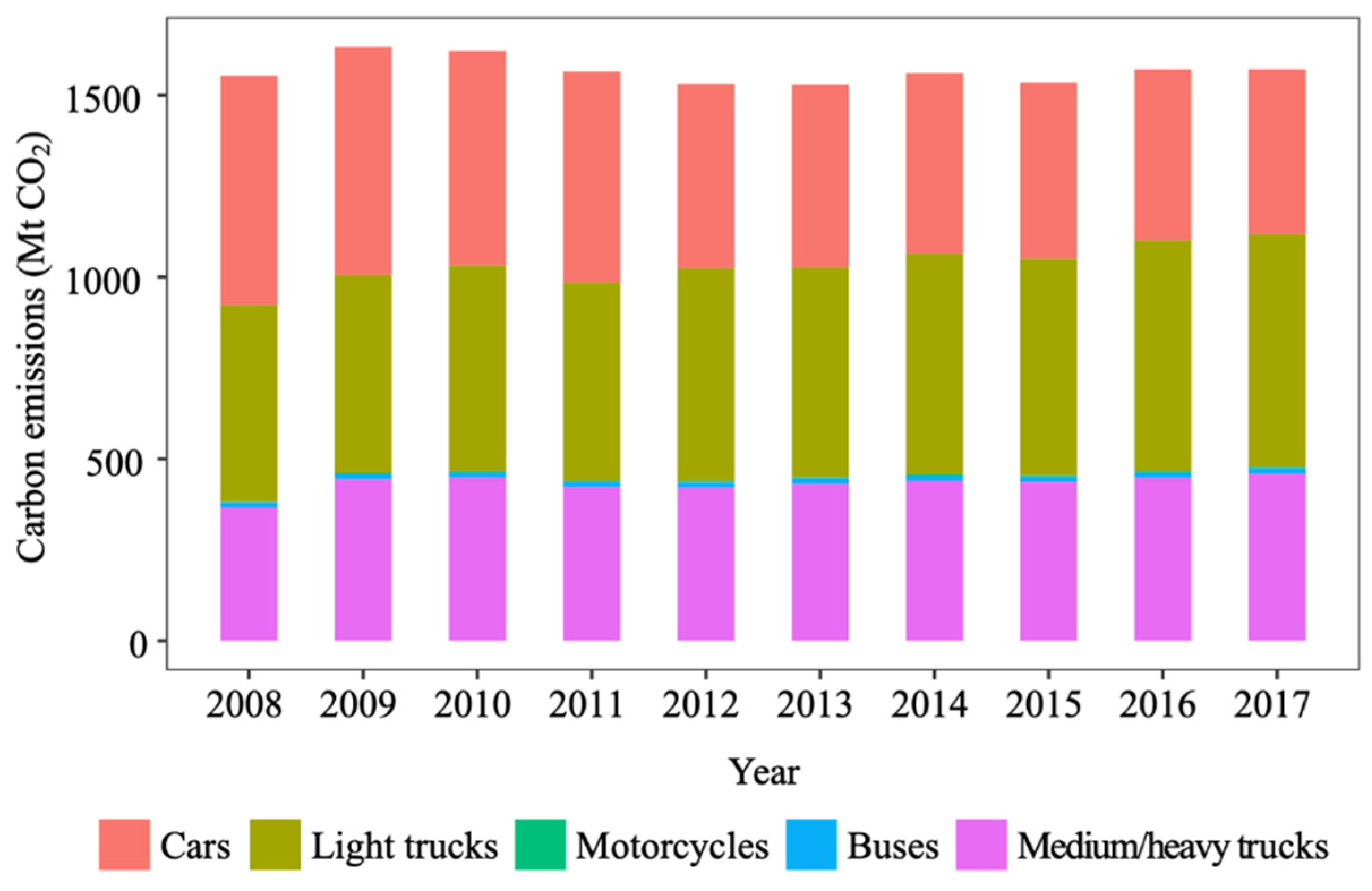
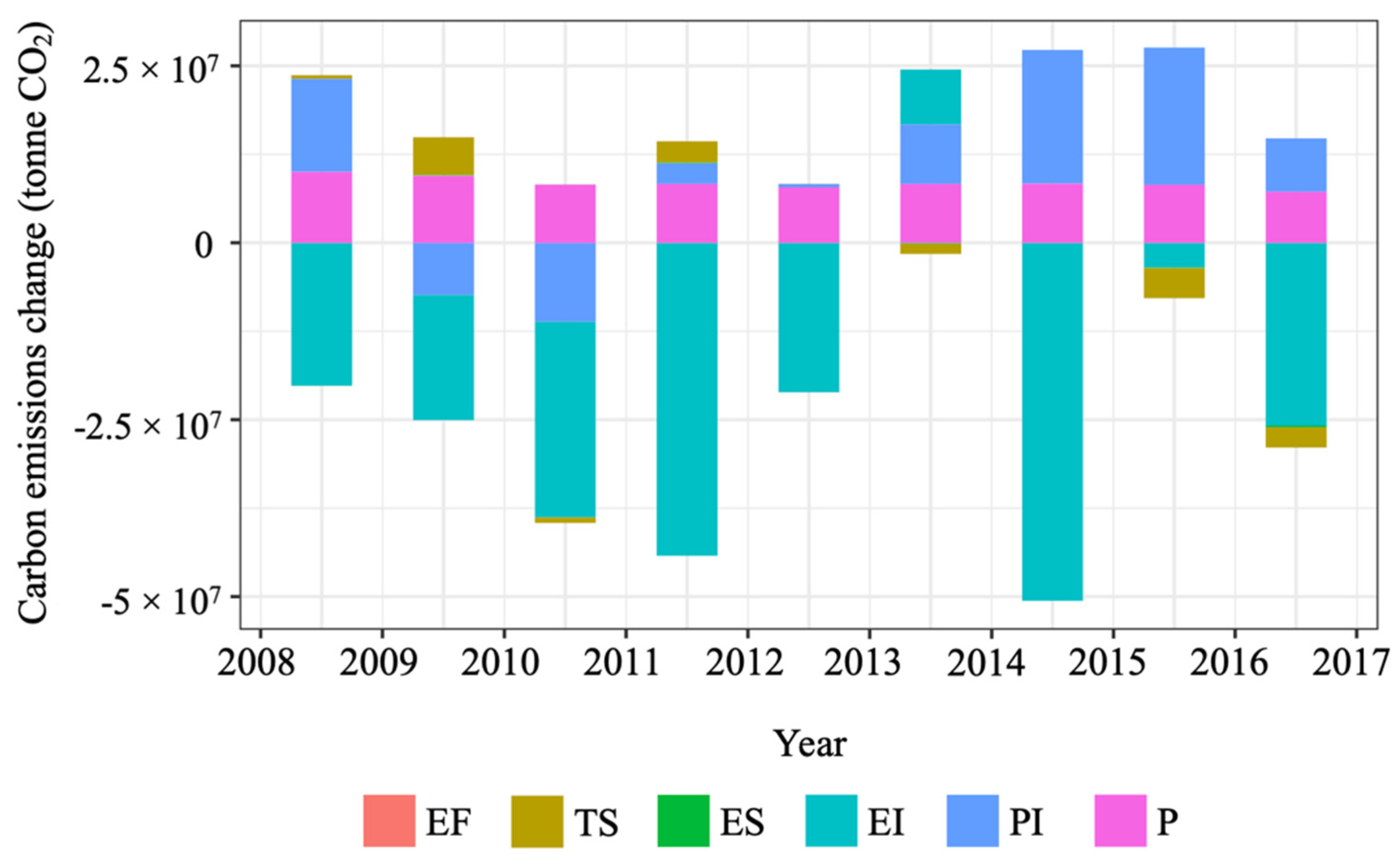
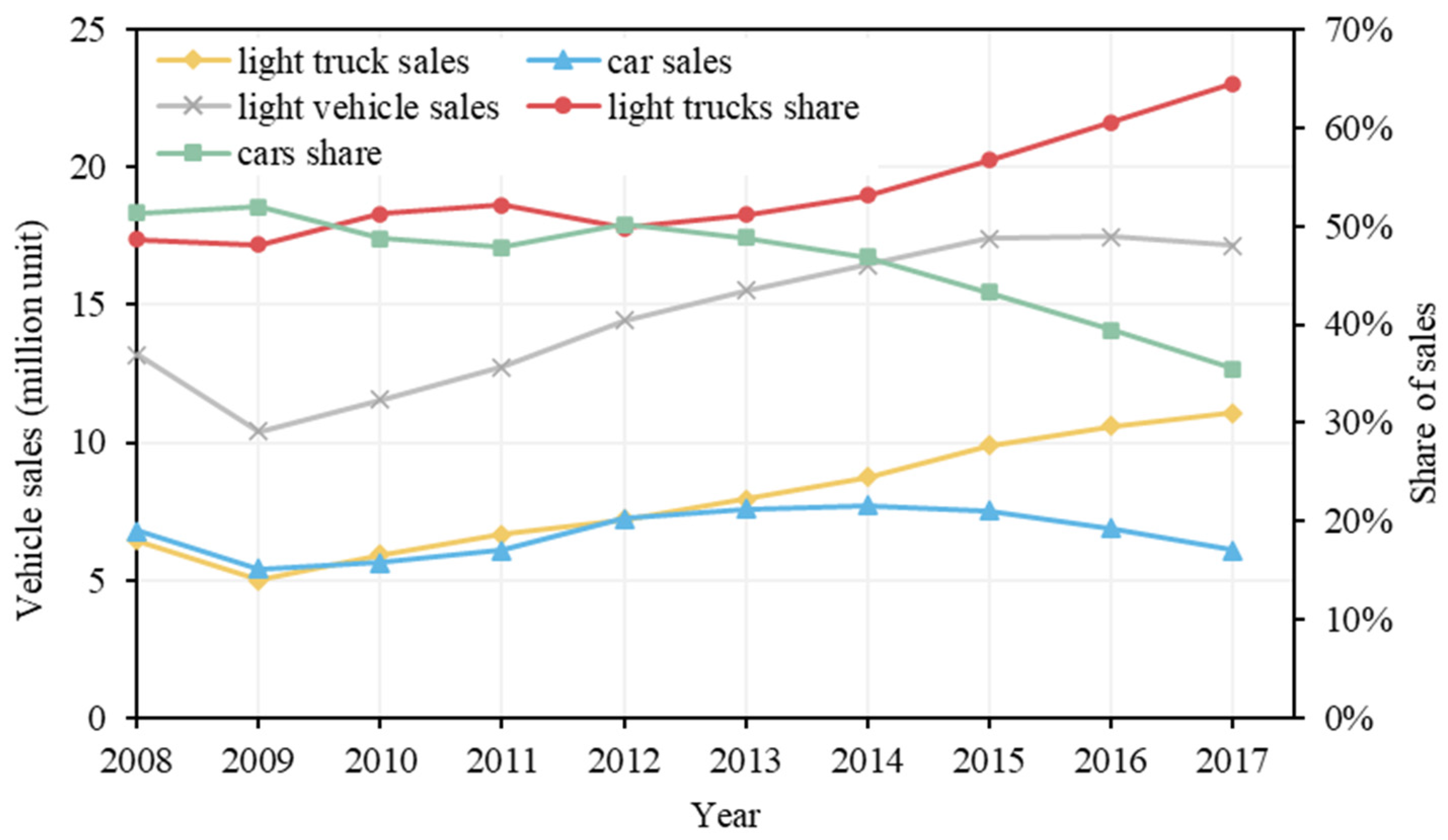
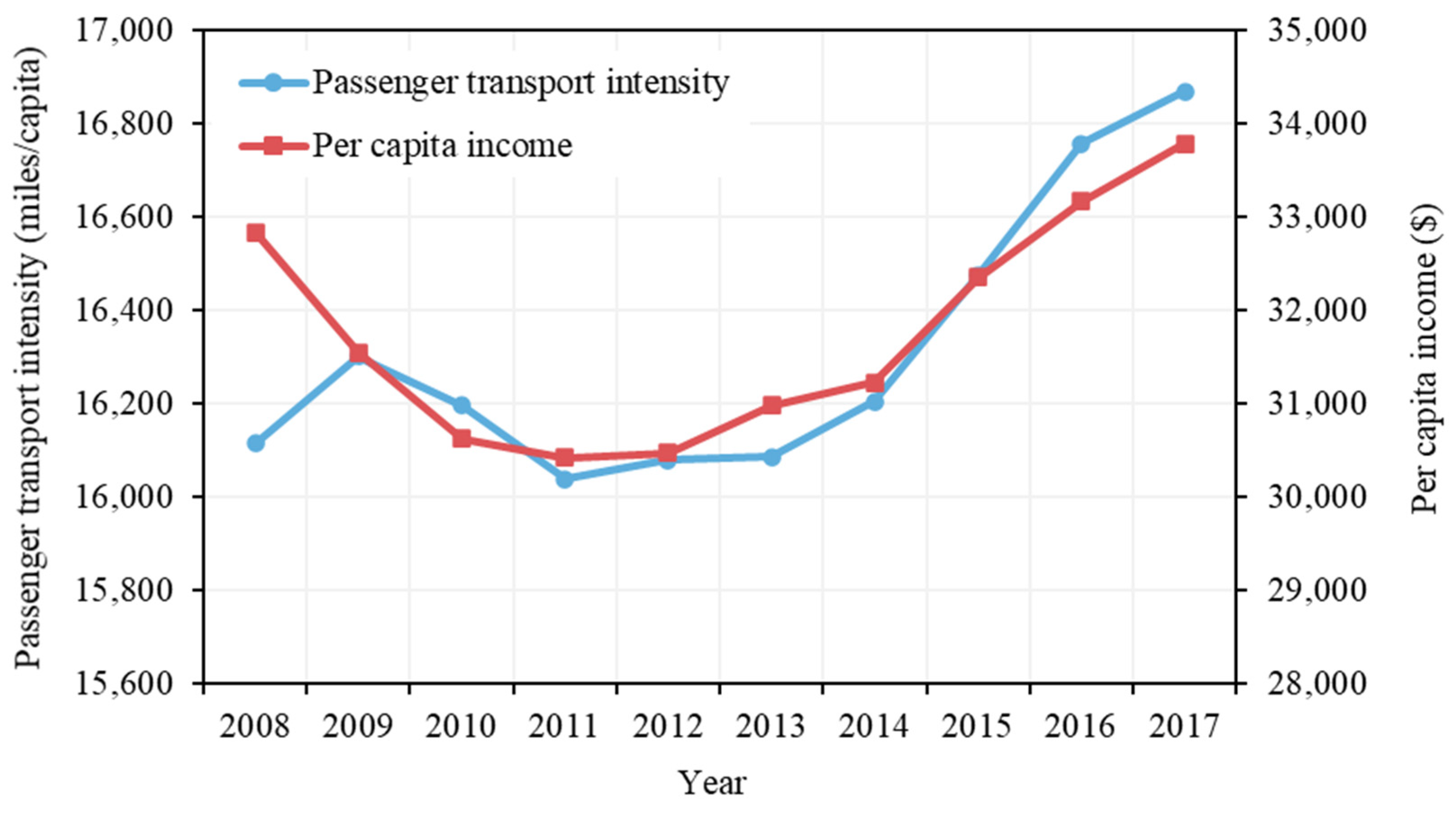
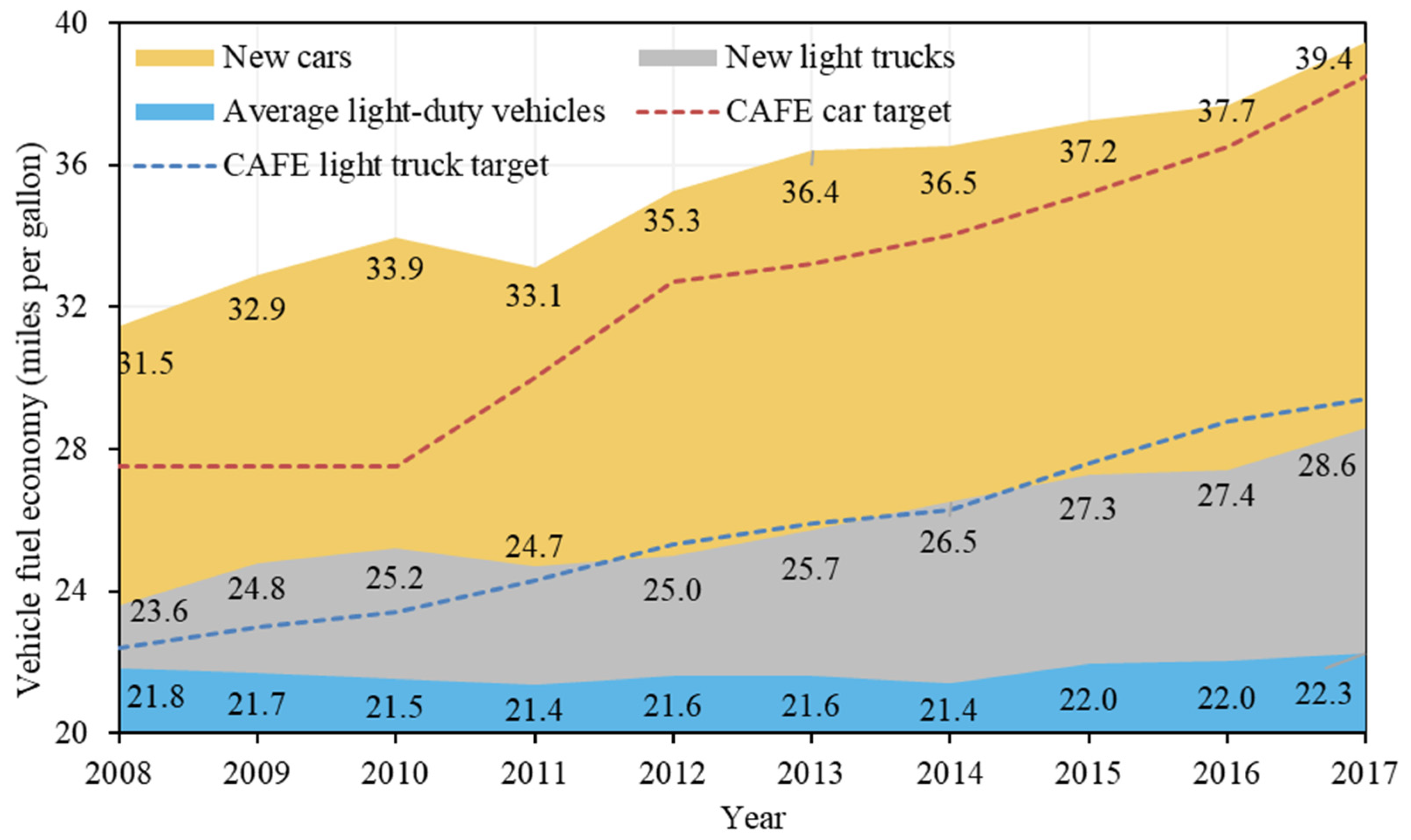
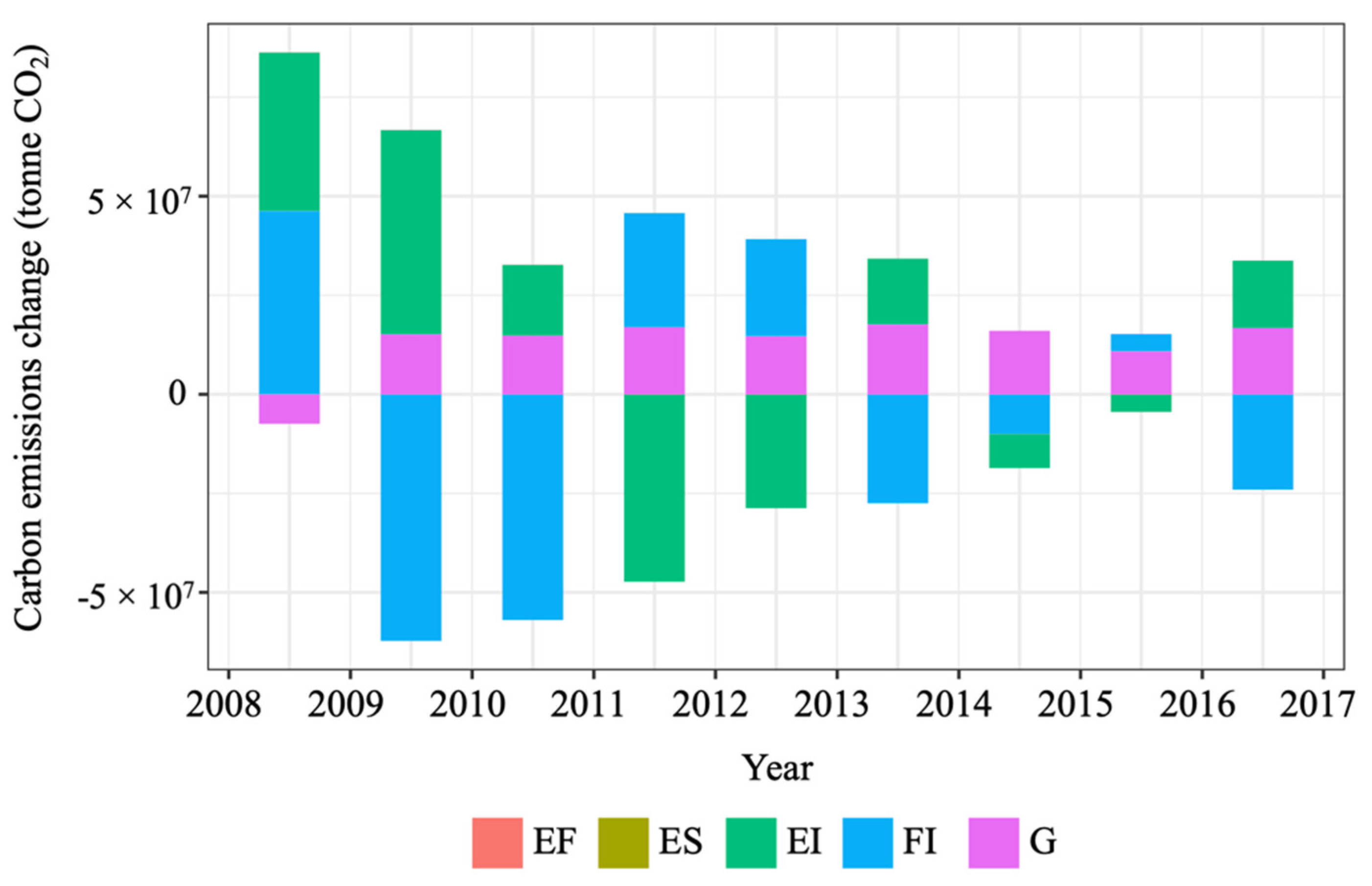
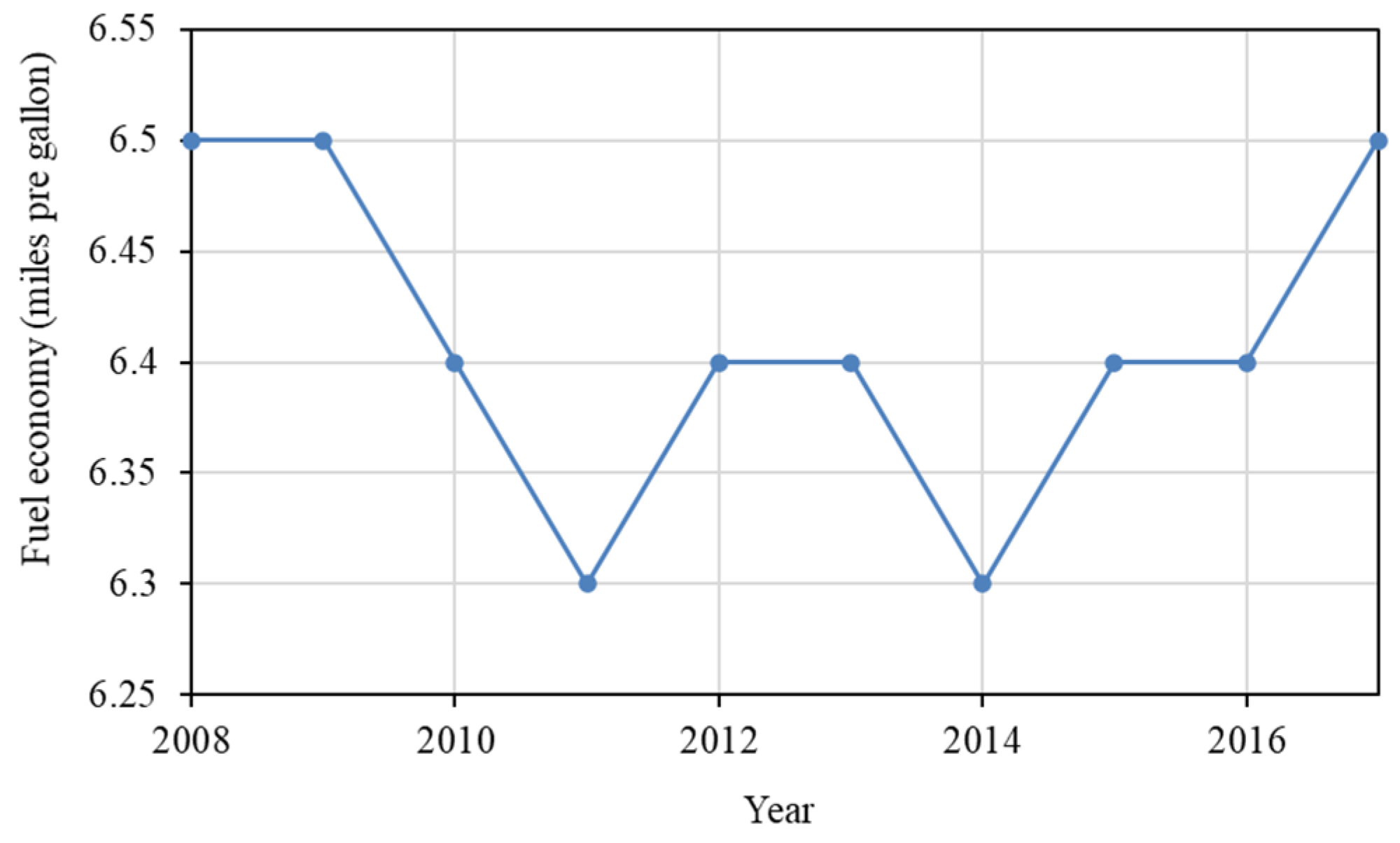
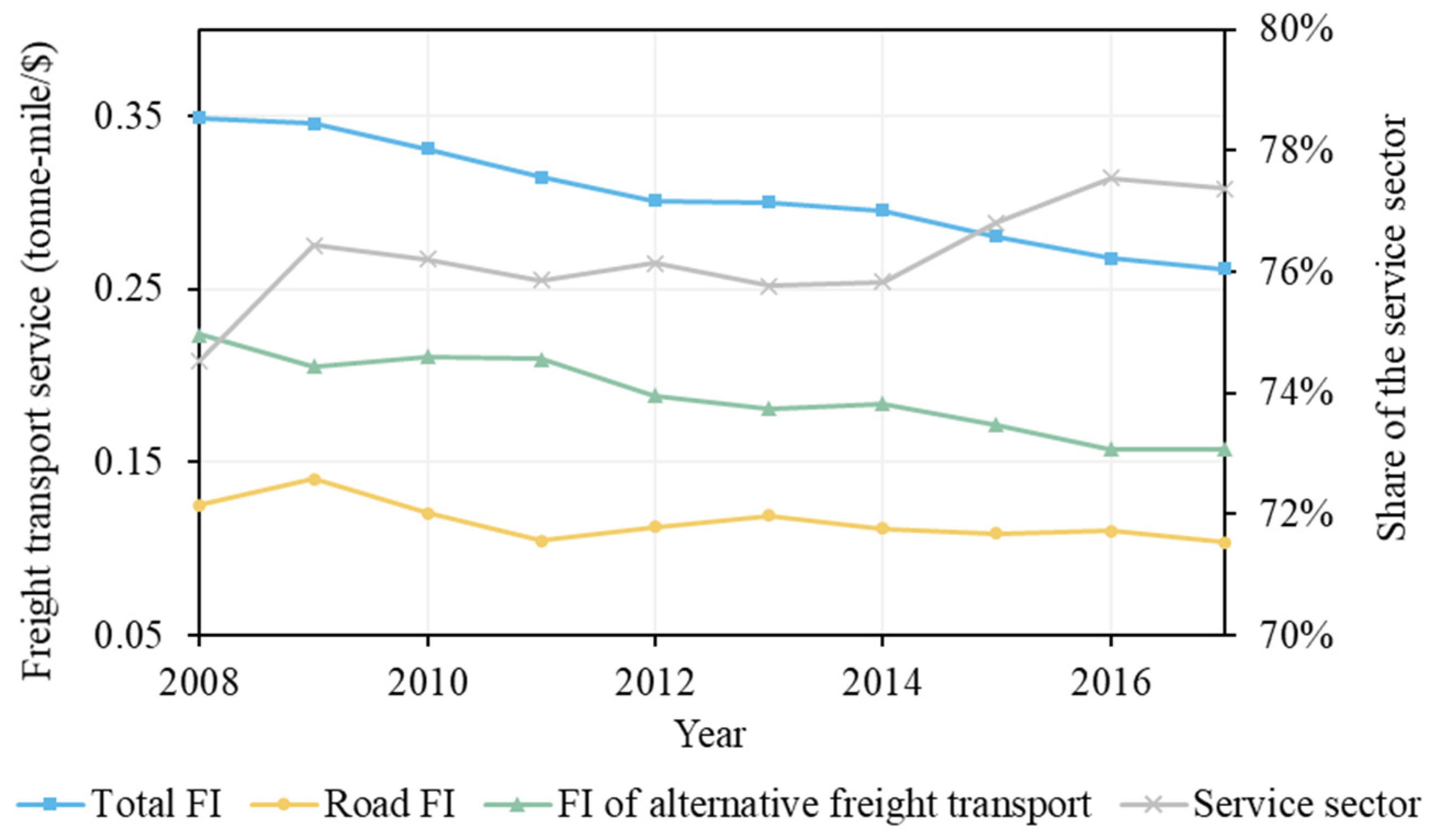
| Year | Studies | Country | Targets | Influence Factors |
|---|---|---|---|---|
| 2005 | [15] | UK | Passenger | Emission coefficient; Fuel structure; Fuel intensity; Occupancy rate; Distance per person; Population. |
| 2007 | [11] | Taiwan, Germany, Japan and South Korea | Road Transport | Emission factor; Population intensity; Vehicle ownership; Fuel intensity; Economic growth. |
| 2009 | [16] | Greece and Denmark | Passenger | Ownership effect; Distance; Fuel mix; Car capacity change; Car engine change; Population. |
| 2012 | [17] | China | Freight | Carbon intensity; Vehicle technology level; Vehicle load; Transport company size; Number of transport companies; Distance; Relations between freight transport and industrialisation; Level of industrialisation; Economic growth. |
| 2013 | [18] | China | Freight | Emission factor; Market concentration; Road freight market share; Industrialisation level; Fuel intensity; Economic growth. |
| 2014 | [19] | Tunisia | Freight | Emission intensity; Energy intensity; Transport intensity. |
| 2015 | [12] | China | Road Transport | Share of vehicle types; Energy intensity of vehicle types; Emission intensity of vehicle types. |
| 2017 | [20] | Tunisia | Road Transport | Energy intensity; Economic development level; Urbanisation; Motorisation, Energy consumption. |
| Method | Application Condition | Advantages | Disadvantages |
|---|---|---|---|
| Index decomposition analysis (IDA) | Usually used to examine the driving factors of energy/energy-related emissions changes in a specific sector (e.g., the transport sector) [21,24,25]. | (1) High flexibility in formulation and application [21]. (2) A large number of factors can be easily handled with the Logarithmic Mean Divisia Index (LMDI) method [21]. (3) Relatively low data requirement. Both data with high or low degree of sector disaggregation can be used [21]. | (1) In SDA terminology, cannot deal with indirect effect [21]. (2) The application is limited in one-stage decomposition models [21]. |
| Structural decomposition analysis (SDA) | Often employed by those comfortable with using input–output analysis [21,25].Primarily used to analyse the energy/emissions changes in the whole economy [21,24,25]. | (1) Both direct and indirect effect is captured [21]. (2) Can include two-stage decomposition models [21]. | (1) Relatively high data requirement [22]. (2) The application relies on the availability of input-output tables, limiting the flexibility [21]. |
| Year | CO2 Emissions Changes (Million Tonnes) | ||||||||||
|---|---|---|---|---|---|---|---|---|---|---|---|
| EF | TS | ES | EI | PI | P | Total | |||||
| Car | Light Truck | Motorcycle | Bus | Total | |||||||
| 2008–2009 | 0.00 | −2.60 | 1.32 | 1.91 | −0.12 | 0.52 | −0.03 | −20.21 | 13.16 | 10.01 | 3.46 |
| 2009–2010 | 0.00 | −25.09 | 31.40 | −0.30 | −0.68 | 5.33 | 0.13 | −17.72 | −7.35 | 9.46 | −10.16 |
| 2010–2011 | 0.00 | 4.89 | −6.32 | 0.08 | 0.55 | −0.80 | 0.02 | −27.66 | −11.14 | 8.22 | −31.34 |
| 2011–2012 | 0.00 | −54.88 | 57.40 | 0.53 | −0.07 | 2.97 | 0.16 | −44.23 | 2.90 | 8.31 | −29.89 |
| 2012–2013 | 0.00 | 0.67 | −0.81 | −0.10 | 0.27 | 0.03 | −0.01 | −21.13 | 0.45 | 7.84 | −12.82 |
| 2013–2014 | 0.00 | −18.70 | 17.88 | −0.13 | −0.48 | −1.43 | −0.15 | 7.75 | 8.43 | 8.31 | 22.91 |
| 2014–2015 | 0.00 | −1.09 | 0.98 | −0.01 | −0.05 | −0.17 | −0.02 | −50.59 | 18.91 | 8.35 | −23.52 |
| 2015–2016 | 0.00 | −28.18 | 24.40 | 0.06 | −0.52 | −4.24 | −0.15 | −3.44 | 19.40 | 8.19 | 19.75 |
| 2016–2017 | 0.00 | −13.95 | 10.52 | −0.01 | 0.58 | −2.87 | −0.24 | −25.83 | 7.55 | 7.21 | −14.18 |
| 2008–2017 | 0.02 | −138.94 | 136.77 | 2.03 | −0.51 | −0.65 | −0.29 | −203.06 | 52.30 | 75.89 | −75.80 |
| Year | CO2 Emissions Changes (Million Tonnes) | |||||
|---|---|---|---|---|---|---|
| EF | ES | EI | FI | G | Total | |
| 2008–2009 | 0.00 | 0.00 | 40.05 | 46.24 | −7.44 | 78.86 |
| 2009–2010 | 0.00 | 0.00 | 51.55 | −62.25 | 15.16 | 4.46 |
| 2010–2011 | 0.00 | 0.00 | 17.88 | −56.97 | 14.81 | −24.28 |
| 2011–2012 | 0.00 | 0.00 | −47.32 | 28.80 | 16.94 | −1.58 |
| 2012–2013 | 0.00 | 0.00 | −28.75 | 24.52 | 14.64 | 10.41 |
| 2013–2014 | 0.00 | 0.00 | 16.61 | −27.53 | 17.65 | 6.73 |
| 2014–2015 | 0.00 | 0.00 | −8.65 | −9.99 | 16.04 | −2.60 |
| 2015–2016 | 0.00 | 0.00 | −4.47 | 4.36 | 10.86 | 10.75 |
| 2016–2017 | 0.00 | 0.00 | 17.01 | −24.08 | 16.74 | 9.68 |
| 2008–2017 | 0.00 | 0.00 | 53.90 | −76.89 | 115.40 | 92.41 |
Publisher’s Note: MDPI stays neutral with regard to jurisdictional claims in published maps and institutional affiliations. |
© 2022 by the authors. Licensee MDPI, Basel, Switzerland. This article is an open access article distributed under the terms and conditions of the Creative Commons Attribution (CC BY) license (https://creativecommons.org/licenses/by/4.0/).
Share and Cite
Jiang, R.; Wu, P.; Wu, C. Driving Factors behind Energy-Related Carbon Emissions in the U.S. Road Transport Sector: A Decomposition Analysis. Int. J. Environ. Res. Public Health 2022, 19, 2321. https://doi.org/10.3390/ijerph19042321
Jiang R, Wu P, Wu C. Driving Factors behind Energy-Related Carbon Emissions in the U.S. Road Transport Sector: A Decomposition Analysis. International Journal of Environmental Research and Public Health. 2022; 19(4):2321. https://doi.org/10.3390/ijerph19042321
Chicago/Turabian StyleJiang, Rui, Peng Wu, and Chengke Wu. 2022. "Driving Factors behind Energy-Related Carbon Emissions in the U.S. Road Transport Sector: A Decomposition Analysis" International Journal of Environmental Research and Public Health 19, no. 4: 2321. https://doi.org/10.3390/ijerph19042321
APA StyleJiang, R., Wu, P., & Wu, C. (2022). Driving Factors behind Energy-Related Carbon Emissions in the U.S. Road Transport Sector: A Decomposition Analysis. International Journal of Environmental Research and Public Health, 19(4), 2321. https://doi.org/10.3390/ijerph19042321






